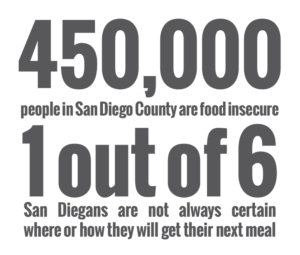7 Things You Can Do to Address Hunger in Your Community
Honoring the 7 year cycle of Shmita:
More than 450,000 people in San Diego County are food insecure, having limited or uncertain availability of nutritious food. This means that roughly one in six San Diegans are not always certain where or how they will get their next meal. Here are ways that you can contribute to the fight against hunger in your community!
Download this guide: 7 Things You Can Do to Address Hunger in Your Community.

1. Volunteer your time:
- …at a community farm. Much of the produce grown on the Farm at the Leichtag Foundation property in Encinitas is donated to local food pantries and distributed to those in need. Stay tuned for ways to volunteer on the Farm to help grow and harvest this produce.
- …with a local gleaning group. Gleaning groups, such as CropSwapSanDiego, help pick fruit and vegetable crops that would otherwise never be picked and go to waste. Volunteering with a gleaning groups is fun way to make an impact while being outside and learning about local agriculture.
- …at a food bank. Local food banks and pantries rely on volunteer labor to sort, bag, and distribute food. Contact the hunger relief organizations listed below for volunteer opportunities.
2. Reduce waste through recovery and donation.
- Call a gleaning group to harvest your backyard fruits trees and donate the fruit to a local food bank.
- Having a catered party? Figure out ahead of time where you can donate the inevitable leftover food. Work with your school or work cafeteria to make sure that unused food is donated to a food pantry. Many people don’t know this and as a result are hesitant to donate their extra food. Contact Donate Don’t Dump for ideas.
- Individuals or businesses who donate food items to food pantries and food banks are protected from all liability under the Emerson Good Samaritan Food Donation Act.
3. Host a food drive. While fresh produce and monetary donations are very important, food banks and pantries can make good use of canned or other shelf-stable foods. For example, most food pantries serve the homeless and busy single mothers, who require or appreciate ready-to-eat foods that can be consumed with little to no cooking. Consider having a food drive outside of the usual holiday season and asking participants to donate a few dollars as well, which agencies can use to purchase food at an exponential discount.
4. Donate money, rather than food. Food banks, food pantries, and other non-profit organizations that fight hunger depend on grants and donations. Because food banks purchase food in bulk and at discounted rates, a donation of one dollar can purchase $20 worth of food. If everyone who attends Sukkot donated one dollar, over 11,000 meals could be provided to men, women and children across San Diego County. Monetary donations to food banks are tax deductible. Please see the end of this document for donation ideas!
5. Help elect officials who care about hunger. Good policy can help to alleviate hunger and with increased advocacy hunger can be on the public agenda. Letters and phone calls to elected officials help remind them that the public is concerned about hunger issues. If you represent a non-profit hunger relief organization, consider joining the Hunger Action Network to learn about more ways that you and your organization can get involved in hunger advocacy.
6. Promote awareness among friends and family. Share this list with your friends and family. Instead of a regular dinner party, host a Hunger Banquet at your school or home. Have discussions about solutions to poverty and hunger issues with your friends. Help bring the issue of food insecurity into the mainstream.
7. Choose a career path that involves hunger. Non-profit workers, policy-makers, and researchers can address hunger issues every day. Even those in the private sector can make this cause a part of their careers. City planners and doctors also can focus on the needs of those that are food insecure.
To donate to and volunteer at local hunger relief organizations, visit the websites of following agencies:
- Jewish Family Service, Hand Up Youth Food Pantry
- Feeding America San Diego
- Jacobs & Cushman San Diego Food Bank
Sign up for the Leichtag Foundation newsletter to stay connected and learn more ways to get involved!






 Stacie and Jeff Cook understand commitment. They live it.
Stacie and Jeff Cook understand commitment. They live it. Black, Jewish and Queer. These three identities weave the fabric of who I am, but it took a long time to believe that they could exist together.
Black, Jewish and Queer. These three identities weave the fabric of who I am, but it took a long time to believe that they could exist together. Lee and Toni Leichtag established the Leichtag Foundation in 1991 following the sale of their business. Lee and Toni were lifelong entrepreneurs with a passion for innovation and for supporting talent. They believed that only with big risk comes big reward. Both born to families in poverty, Toni to a single mother, they strongly believed in helping those most in need and most vulnerable in our community. While they supported many causes, their strongest support was for young children and the elderly, two demographics who particularly lack voice in our society.
Lee and Toni Leichtag established the Leichtag Foundation in 1991 following the sale of their business. Lee and Toni were lifelong entrepreneurs with a passion for innovation and for supporting talent. They believed that only with big risk comes big reward. Both born to families in poverty, Toni to a single mother, they strongly believed in helping those most in need and most vulnerable in our community. While they supported many causes, their strongest support was for young children and the elderly, two demographics who particularly lack voice in our society. Lifelong Baltimoreans, Rabbi George and Alison Wielechowski and their sons, 11-year-old Lennon and 9-year-old Gideon, are more than pursuing the good life in Southern California. Having moved to San Diego more than three years ago, they are fulfilling a lifelong dream.
Lifelong Baltimoreans, Rabbi George and Alison Wielechowski and their sons, 11-year-old Lennon and 9-year-old Gideon, are more than pursuing the good life in Southern California. Having moved to San Diego more than three years ago, they are fulfilling a lifelong dream.





 You would think that as the executive director of San Diego LGBT Pride, Fernando Zweifach López Jr., who uses the pronoun they, has done all the coming out they possibly can. A queer, non-binary individual who has worked for many years on civil rights issues, López also speaks openly and often about their father’s family, Mexican-American migrant workers who tilled the fields of rural California.
You would think that as the executive director of San Diego LGBT Pride, Fernando Zweifach López Jr., who uses the pronoun they, has done all the coming out they possibly can. A queer, non-binary individual who has worked for many years on civil rights issues, López also speaks openly and often about their father’s family, Mexican-American migrant workers who tilled the fields of rural California.